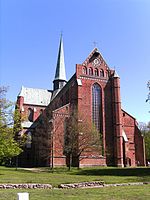Stege and Waidbach
Mecklenburg-Western Pomerania river stubsRivers of GermanyRivers of Mecklenburg-Western PomeraniaTributaries of the Warnow

Stege and Waidbach are two small rivers in Mecklenburg-Vorpommern, Germany, forming a pseudobifurcation. This means, they are linked by a waterbody that is drained in both directions. The common top section is fed by sources in small valleys at the eastern slope of Kühlung hills. The northern part, Stege, flows into the Mühlenfließ in Bad Doberan. The southern part, Waidbach, flows into the Beke near Ziesendorf.
Excerpt from the Wikipedia article Stege and Waidbach (License: CC BY-SA 3.0, Authors, Images).Stege and Waidbach
L 13,
Geographical coordinates (GPS) Address Nearby Places Show on map
Geographical coordinates (GPS)
| Latitude | Longitude |
|---|---|
| N 54.116 ° | E 11.9167 ° |
Address
L 13
18209
Mecklenburg-Vorpommern, Germany
Open on Google Maps









